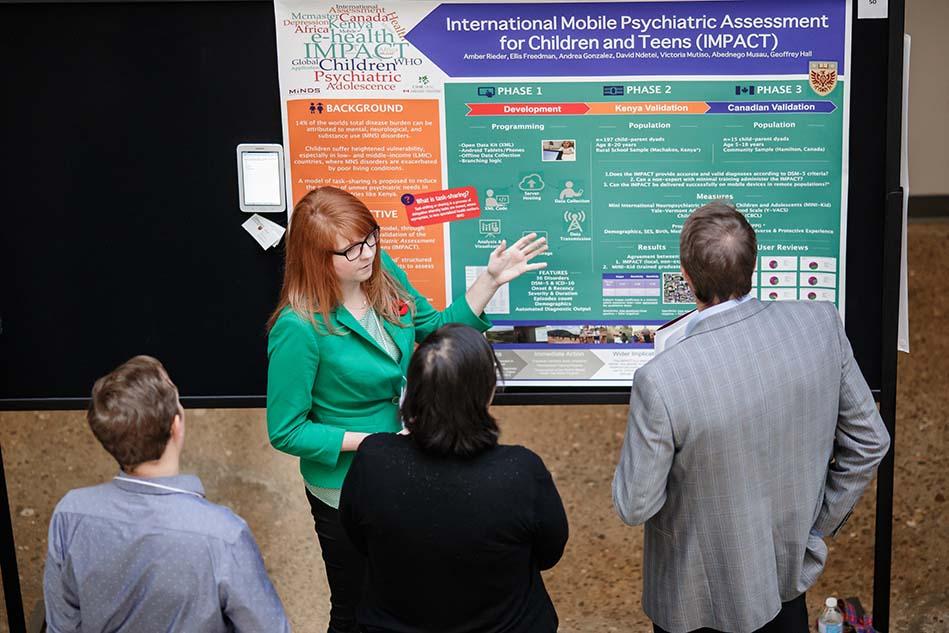Emerging MiNDS
AUTHOR: Steven Mancini

AMBER RIEDER
Who is your supervisor?
Dr. Geoffrey Hall
What is your research question?
Background: The International Mobile Psychiatric Assessment for Children and Teens (IMPACT) was developed in response to globally over-burdened psychiatric systems and frequently unmet psychiatric needs, especially in low- and middle-income countries. The objective of this study is to apply a task-shifting model, where non-experts are trained to assess children and adolescents using a comprehensive and highly structured interview on standard mobile phones and tablets. IMPACT was developed for administration in regions with scarce human resources, and where expertise in psychiatry and mental health, are limited.
Questions: 1.Does the IMPACT (using non-expert interviewers) produce valid diagnoses according to DSM-5 criteria when compared to the MINI-Kid? Does IMPACT produce stable and reliable results following re-administration, 7-14 days later?
What are the main methodologies/techniques that you use to address this research question?
~200 rural school children (equivalent to grade 7-12) and their caregivers from Machakos, Kenya, were interviewed using the newly developed IMPACT on mobile tablets. The IMPACT was administered by non-expert, local, community members. Cohen’s Kappa, sensitivity, specificity, and test-retest reliability of the IMPACT were measured in comparison with the gold standard in the region, the MINI-Kid. The MINI-kid was administered by trained and experienced graduate students from McMaster University. Agreement between DSM-5 and ICD-10 diagnoses were examined.

What are the most important potential implications of your research?
The IMPACT is the first structured diagnostic interview with automated algorithmic output, using the latest criteria of the DSM-5 and ICD-10 codes. It is also the first offline ‘mobile’ assessment for tablet/mobile phone to be used to assess the mental status of children and adolescents in resource scarce and hard-to-reach regions. The IMPACT is a relatively valid and reliable, globally accessible, measure of childhood psychiatric illness promoting its use for clinical practice and epidemiological research settings, especially in low- and middle-income countries.
How can students get in touch with you if they have more questions?
riedera@mcmaster.ca
LAURA KEATING
Who is your supervisor?
Dr. Sue Becker and Dr. Margaret McKinnon (co-supervisors)
What is your research question?
What is the impact of aerobic and non-aerobic exercise on symptoms of stress, anxiety, depression, and on neurocognitive function?
What are the main methodologies/techniques that you use to address this research question?
We are doing research on human subjects across several different methods including retrospective chart review, prospective observational and prospective interventional. These three different approaches are being used to address several different knowledge gaps in the literature on how exercise improves symptoms of mood (stress, anxiety, depression) and neurocognitive function in youth and adults with and without mood disorders.
What are the most important potential implications of your research?
Research suggests that aerobic exercise is an effective way of managing symptoms of stress and depression in adults with mood disorders. Research in animals also suggests that aerobic exercise may have a positive impact on neurocognitive function. We are seeking to further clarify these general findings in youth and adults with and without mood disorders. Specific questions include whether positive effects of aerobic exercise also benefit youth and adults with complex clinical histories including treatment resistant mood disorders, or with multiple co-morbidities. Additional questions include “Are the beneficial effects that have been reported attributable to aerobic exercise?” and “Can similar benefits be achieved through non-aerobic exercise (e.g. yoga)?” Further, neurocognitive impairment is a core symptom of mood disorders, but the effects of exercise on neurocognitive function have not been well studied in humans. The research that I am doing may identify if and how exercise impacts learning and memory in youth and adults, both healthy and those with chronic and/or complex mental illness. The results from this research will provide a clearer understanding of the benefits that can be expected as a result of aerobic and/or non-aerobic exercise, and identify some areas in the brain that may specifically benefit from exercise.
How can students get in touch with you if they have more questions?
Email is best: scuttle@mcmaster.ca

CAITLIN SIU
Who is your supervisor?
Dr. Kathy Murphy
What is your research question?
How does the human visual cortex develop across the lifespan?
What are the main methodologies/techniques that you use to address this research question?
I have studied postmortem human visual cortex samples from people that ranged in age from 20 days to 80 years old. Using Western blotting I was able to measure protein expression of over 16 different excitatory and inhibitory synaptic proteins, glial and extracellular matrix proteins in primary and extrastriate human visual cortical areas.

What are the most important potential implications of your research?
I have shown evidence for prolonged synaptic plasticity in the human visual cortex extending into adulthood that could support lifelong plasticity and visual perception. Implications for this research are important for the development of therapies for visual system disorders including amblyopia, as well as other therapies that could rely on synaptic plasticity throughout the lifespan. Finally, my research contributes to bridging the gap between structure and function in the human brain.
How can students get in touch with you if they have more questions?
siucr@mcmaster.ca